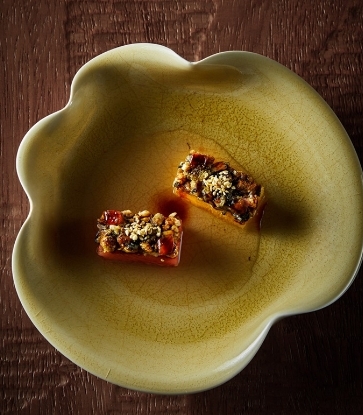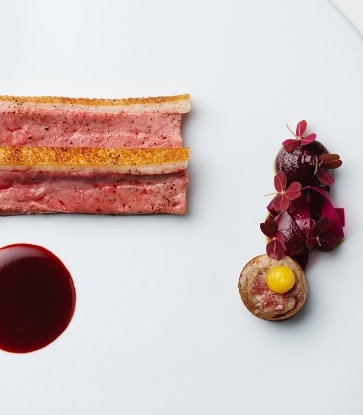A tasting menu at San Francisco’s three-Michelin-starred Benu starts with the intriguingly named “small delicacies”. Essentially a series of exquisitely plated single-bite seasonal morsels brought out in rapid fire sequence, each delicacy offers a different taste and texture profile that ranges from subtly umami to bold and crunchy, leaving diners excitedly anticipating the next surprise to be unveiled.
There is a method to this madness though. By the time the sequence of about ten dishes have been devoured, one realises that all five taste sensations - salty, sour, sweet, bitter and umami - have been awakened, all the better to enjoy the rest of the banquet.

His mastery of Asian ingredients and flavours is apparent with subsequent plates - the pungent thousand-year-old quail egg over potage is a surprising crowd favourite while frog’s leg velvet with shiga rice porridge inspires memories of mum’s comfort cooking. The final course is beef rib steak accompanied with Korean condiments like pickled ginger and miso paste and melds Asian and American influences so flawlessly that all that matters is putting together the perfect blend of flavours with every bite.

Hit the streets
While chefs in the echelons of fine dining are the ones that often make the headlines, the street food scene, which is an essential element of Asian culinary culture, is buzzing too. There is no need to wait for Anthony Bourdain’s highly anticipated food hall (read: hawker centre) in New York City to open in 2019. Simply take a trip to Portland, Oregon, ground zero of the food truck phenomenon, to find out how Asian street food is evolving in the United States.
At any given food truck park (in Portland, food trucks often converge at parking lots or open spaces), it is almost par for the course to spot at least one offering Asian food among the myriad trucks peddling Instagram-friendly mini donuts, artisanal grilled cheese sandwiches and the ubiquitous tacos and burritos. This is where food adventurers will discover funky fusion mash-ups like bacon cheeseburger dumplings or bulgogi tacos, which are fun to sample, provide excellent conversation fodder and might just become the next hipster food trend.

Poonsukwattana’s dish comprises succulent poached free range chicken, jasmine rice cooked in chicken stock and chicken broth, all pulled together nicely with a Thai-style sauce of fermented soy beans, chilli, vinegar, ginger and garlic. Just like an exceptional plate of chicken rice found in any part of the world would, her rendition offers not just a multi-layered study of the aromatic flavours of the fowl but also that elusive sense of comfort and satiety that a familiar favourite brings.
Today, Nong’s Khao Man Gai is a Portland institution and the business has expanded from a lone food cart in 2009 to two food trucks and a permanent eatery and its bottled sauces are even sold in supermarkets for those who can’t get enough of it.

No tasting tour of Asian food in the United States is complete without a meal at either Momofuku Noodle Bar in New York City or Mission Chinese Food in San Francisco. As two of the pioneers of mod Asian American cuisine, the evolving menus here offer insight into how this cuisine has changed over the past 15 years.
Momofuku Noodle Bar, the first of David Chang’s now international empire, opened in 2004 and made a splash with his version of the Japanese staple, ramen, which incorporated influences from his Virginia childhood. Bowls of springy noodles doused in flavourful bone broth were served with a surfeit of toppings both traditional and unconventional, including eggs with liquid yolks, bamboo shoots and pulled pork shoulder. The upsized portions were distinctly American, although they seem to have shrunk in recent years. Perhaps better to encourage orders of small sharing plates like barbecued pork belly ssam or steamed Chinese buns. Today, the Noodle Bar also has fried chicken cooked two ways for groups of four and up - Southern-style with buttermilk and Korean triple fried with a spicy glaze.
Over at Mission Chinese Food, which proudly declares that it serves “Americanized Oriental Food”, the restaurant which began as a pop-up within an actual Chinese restaurant is now a full-blown restaurant with outlets in both San Francisco and New York City. When it launched as a pop-up within San Francisco’s Lung Shan restaurant in 2001, word-of-mouth had curious diners queueing up for hours for chef Danny Bowien’s unconventional take on Chinese food.

Finally, just in case there are any leftovers, be sure to partake in an American dining tradition and pack them in a doggy bag, because they will taste incredible over a bowl of piping hot rice the next day. Now that’s East meets West at its best.




















